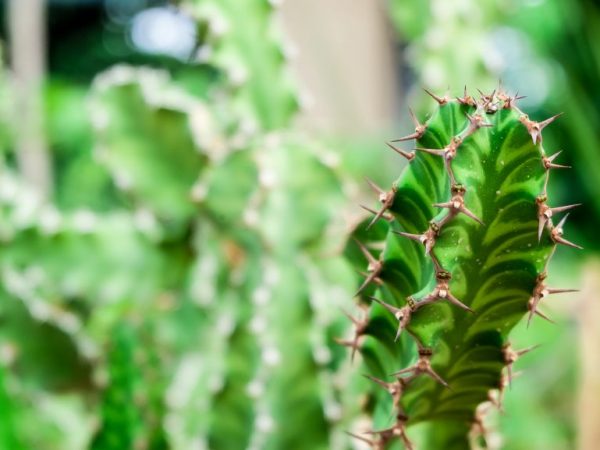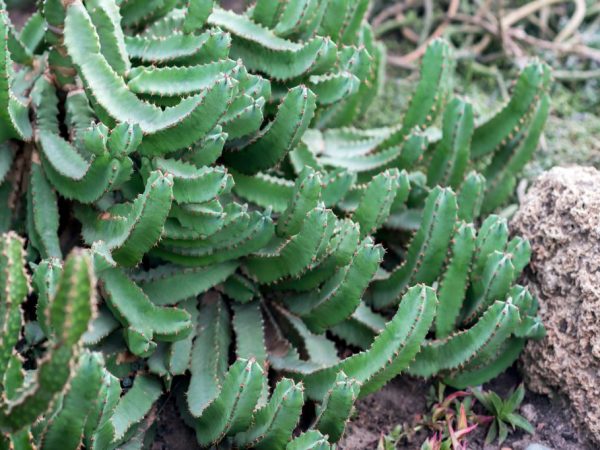Euphorbia resinous - how to care for a plant
Euphorbia resinifera is a perennial succulent native to hot Africa. It grows on the slopes of the Moroccan mountains. The name of this species illustrates one of its features: the frozen juice of euphorbia becomes a resin that is used for medicinal purposes.

Euphorbia resinous - how to care for a plant
general description
The plant reaches a height of 80-120 cm, and can grow up to 150-200 cm wide. Outwardly, this species resembles a cactus.
The fleshy tetrahedral stems grow vertically, in large numbers forming a whole cushion. They have sharp thorns and small brownish leaves that quickly fall off.
The color of the milkweed is green with a bluish tinge. From above it is crowned with small yellow inflorescences.
In the event of a break or other damage, a cloudy sap flows out of the plant. It irritates the skin and mucous membranes, so all work with euphorbia is carried out with gloves.
When solidified, the liquid turns into a yellowish gum, which doctors and veterinarians use externally as an abscess.
Purchase and adaptation
You can buy resinous euphorbia at a specialized store. The cost usually depends on the size of the flower. So, an adult beautiful specimen with a height of 70-80 cm is offered at a price of 4-6 thousand rubles.
When purchasing, make sure that the barrel is free of foreign stains, deposits and damage.
- Leave the euphorbia in quarantine for the first two to three weeks - away from other plants.
- Determine a warm place with good lighting for it, water as needed.
- Examine the flower regularly for signs of pests and diseases.
- It is better to transplant the spurge not immediately, but after a month and a half, when he gets used to the new conditions.
The necessary conditions
The culture is completely unpretentious to soil fertility - any soil with a slightly acidic reaction will do.
The best option is a special soil mixture for succulents, but you can also purchase a universal one.
Since this flower is native to Africa and grows on mountain slopes, it needs a lot of sunlight. It is better to put the pot of milkweed in the southern part of the house on the windowsill. The plant feels great under diffused rays and tolerates straight lines adequately.
Ideal temperature:
- in summer - 25-26 ° С;
- in winter - from 14 ° С to 16 ° С, but not lower than 12 ° С.
Succulent plants calmly tolerate heat up to 30-32 ° C.
Humid air is not important - euphorbia is quite resistant to droughts. However, in the summer, spraying will be useful to him. They will not only increase humidity, but also wash off dust from the trunk, refresh and improve decorativeness.
Care

The plant is easy to care for
Euphorbia resinous is not too whimsical to growing conditions. She loves light and does not tolerate waterlogging, in summer she needs more frequent watering than in winter.
Simple care measures will be the best prevention and will help you grow a flower that is healthy, beautiful and pleasing to the eye.
Top dressing
Feeding should be applied in moderation. You can feed the flower in spring or summer 1-3 times a season.Complex fertilizers for succulents or universal fertilizers (without excess nitrogen) are suitable.
Watering
Water the plant as the topsoil dries out. Usually - once a week or one and a half. During the period of winter dormancy - less often (monthly). Use soft, settled water at room temperature.
Transfer
This type of milkweed is rarely transplanted, since it grows slowly. A transplant is done every 4-6 years, when the root system becomes cramped in the pot. For euphorbia resinous choose a high and stable container with holes at the bottom.
The procedure is carried out by the transshipment method, always wearing gloves. Drainage is laid in the first layer, and then a new soil mixture. They make a depression the size of an earthen coma and carefully place the plant, after which it is watered and covered with a substrate.
Reproduction methods
Euphorbia is propagated by cuttings or seeds. The first way is much easier.
Cuttings are carried out in May. A twig 7-8 cm long is cut off and dried from the juice (the cut point on the parent plant is treated with crushed coal). Then it is kept for several hours in a root solution and placed in water or succulent substrate for rooting.
In the second method, mature seeds are sown in a soil mixture with sand or perlite in March. The soil is well moistened, and the container is covered with a film. After two to three weeks, sprouts appear. Seedlings are regularly watered and aired, and when they get stronger, they are transplanted. Alternatively, you can plant one seed at a time in separate cups.
Diseases and pests
| Problem | Symptoms | Prevention measures | How to treat |
| Whitefly | The appearance of small insects with white wings, and then a black sooty fungus. | Correct watering regime (the top layer should dry well before the next procedure); Regular ventilation. | Washing with soapy water; The use of adhesive tapes for catching insects; Treatment with biological products, and in case of serious damage - with insecticides like Actellik. |
| Mealybug | Sticky yellowish or white coating cotton wool. | The flower should be regularly inspected, sprayed and wiped with a damp cloth. | Insects are cleaned with a brush with water and laundry soap; In serious cases, Aktara or Fitoverm is used. |
| Mold | Light fluffy spots. | Moderate watering. | Remove mold, remove affected leaves. Transplant the plants into new soil, treat with Aktellik. |
| Root rot | Slow growth, brown spots on the stem. | Disinfection of seeds before planting; Moderate watering and feeding. | Remove damaged parts of the flower; Treat with Trichodermin, Mikosan or Copper sulfate. Transplant the plant into a new substrate. |

